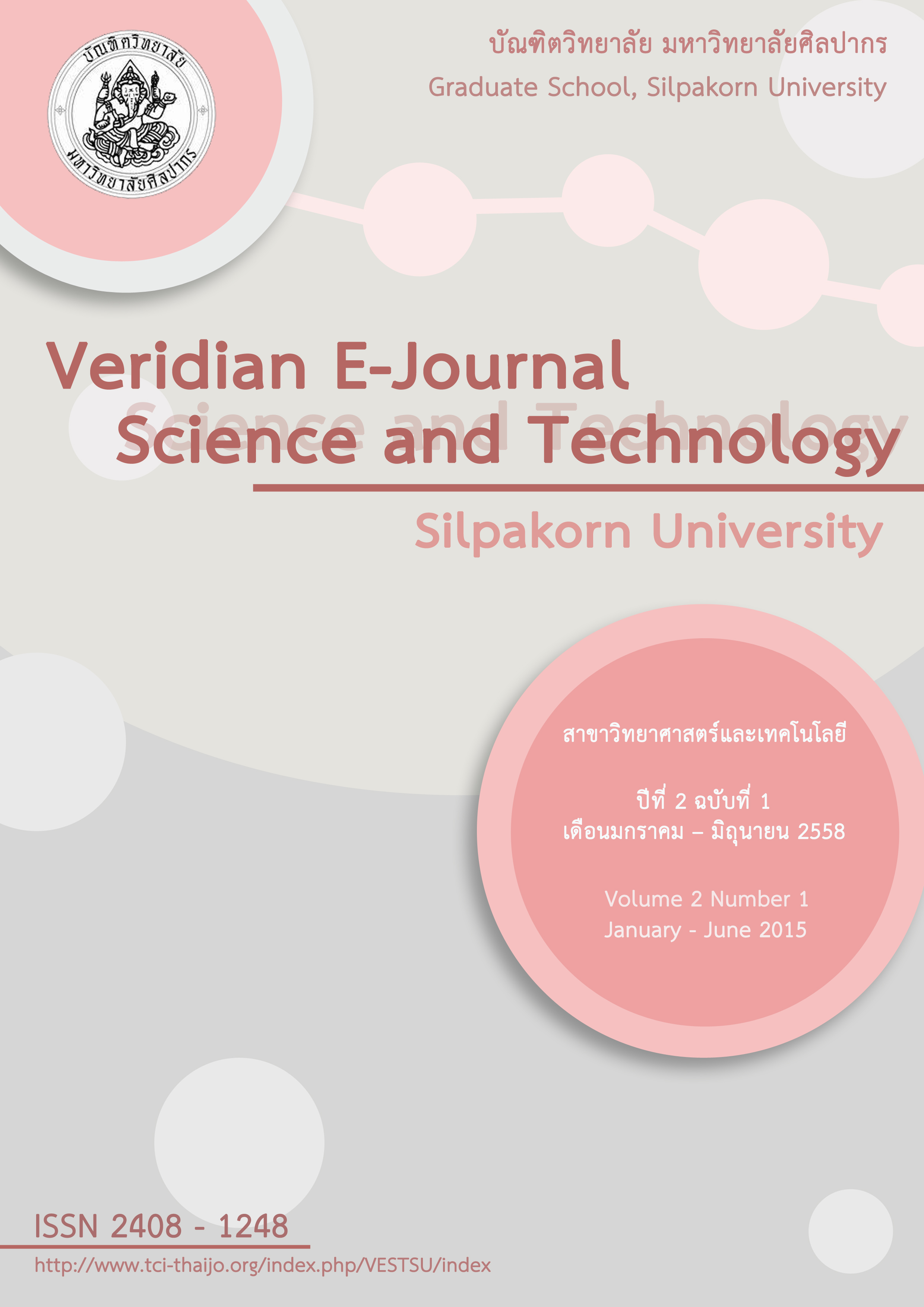การศึกษาสถานภาพปัจจุบันเกี่ยวกับกรีนไอทีของมหาวิทยาลัยราชภัฏในกรุงเทพมหานคร
Main Article Content
Abstract
การวิจัยนี้มีวัตถุประสงค์เพื่อศึกษาสถานภาพทั่วไป ในประเด็นนโยบาย การดำเนินงาน ความรู้ ทัศนคติ พฤติกรรม เกี่ยวกับกรีนไอที และรูปแบบการจัดการกรีนไอทีของมหาวิทยาลัยราชภัฏ 6 แห่ง ในกรุงเทพมหานคร ทำการเก็บข้อมูลจากกลุ่มตัวอย่าง 3 กลุ่ม ได้แก่ ผู้บริหารเทคโนโลยีสารสนเทศระดับสูง ผู้ปฏิบัติงานด้านการบริหารจัดการเทคโนโลยีสารสนเทศ และผู้ใช้งานเทคโนโลยีสารสนเทศ โดยใช้แบบสอบถามที่ผ่านการตรวจสอบคุณภาพและทดสอบความเชื่อมั่นเป็นเครื่องมือในการวิจัย สถิติที่ใช้ในการวิจัย ได้แก่ ความถี่ ร้อยละ ค่าเฉลี่ย ส่วนเบี่ยงเบนมาตรฐาน และฐานนิยม
ผลการวิจัยพบว่า ในภาพรวมมหาวิทยาลัยราชภัฏในกรุงเทพมหานครมีการกำหนดนโยบายด้านการจัดการกรีนไอที (ร้อยละ 65.38) โดยนโยบายที่ได้มีการกำหนดไว้เป็นส่วนใหญ่ ได้แก่ วงชีวิตอุปกรณ์ไอที รองลงมา ได้แก่ การวัด ติดตาม และประเมินผลการใช้พลังงานไฟฟ้า และ การใช้ไอทีเพื่อลดการปลดปล่อยก๊าซคาร์บอนไดออกไซด์ ส่วนนโยบายที่ยังไม่ได้กำหนดไว้ ได้แก่ การบริหารจัดการศูนย์ข้อมูล (data center) เพื่อการประหยัดพลังงาน และแนวปฏิบัติผู้ใช้งานเทคโนโลยีสารสนเทศ สถานภาพทั่วไปของการจัดการกรีนไอที พบว่า กลุ่มตัวอย่างส่วนใหญ่ไม่ทราบข้อมูลรายจ่ายและการตรวจวัดการใช้พลังงานไฟฟ้า ทุกมหาวิทยาลัยมีการรณรงค์การประหยัดพลังงานไฟฟ้า มีความรู้ด้านกรีนไอทีในระดับปานกลาง ( = 4.33, S.D.= 1.70) มีทัศนคติกรีนไอทีอยู่ในระดับมาก ( = 4.11, S.D.=0.53) และมีพฤติกรรมกรีนไอทีอยู่ในระดับปานกลาง ( = 3.50, S.D.= 0.57) รูปแบบการจัดการกรีนไอทีเพื่อการประหยัดพลังงานไฟฟ้าในมหาวิทยาลัยราชภัฏประกอบด้วย 5 มิติ ได้แก่ 1) การใช้ไอทีเพื่อลดการปลดปล่อยปริมาณคาร์บอน 2) การบริหารจัดการศูนย์ข้อมูล 3) ผู้ใช้งานไอที 4) วงชีวิตอุปกรณ์ไอที และ 5) การกำหนดตัวชี้วัดการดำเนินงานด้านกรีนไอที พบว่าในภาพรวมของมหาวิทยาลัยราชภัฏ 6 แห่งในกรุงเทพมหานครมีการจัดการกรีนไอทีเพื่อการประหยัดพลังงานไฟฟ้าอยู่ในระดับต้องปรับปรุงคิดเป็นระดับคะแนนเท่ากับ 1.94 โดยมิติที่ต้องปรับปรุงอย่างเร่งด่วน คือ การกำหนดตัวชี้วัดการดำเนินงานด้านกรีนไอที
Abstract
This research aims to study the general condition of Green Information Technology (Green IT) in terms of policy, administration, knowledge, attitude and behaviors and Green IT managing pattern in 6 Rajabhat universities in Bangkok. The collected data derived from 3 sample groups: Chief Information Officer (CIO), IT administrators and IT users. The well-qualified and reliable questionnaires are used as a research mean. Statistical methods used in the research are cumulative frequency, percentage, mean, standard deviation and mode.
The research showed that Rajabhat universities in Bangkok generally have a definite policy to deal with Green IT (65.38%). The policies are mostly arranged about IT equipment life cycle. The next on down policies are measurement, follow up and evaluation of electricity consumption and also operating IT in order to decrease the carbon dioxide emission. The unplanned policies are the data management for power saving and the general procedure for the IT users. In general, it is found that most of the sample groups did not know about the expenses and the electric consumption measurement. Every universities has a power saving campaign, the knowledge about Green IT at the medium level ( = 4.33, S.D.= 1.70), the attitude towards Green IT with high level ( = 4.11, S.D.=0.53), and the Green IT behavior at medium level ( = 3.50, S.D.= 0.57). The Rajabhat university’s Green IT management model of power saving consists of 5 aspects as follows: 1) IT application to lower the carbon emission, 2) the management of data center, 3) IT users, 4) IT equipment life cycle and 5) key performance indicators for green IT operation. The research reviewed that Green IT for power saving policy needs improvement equal to 1.94. The urgent requirement is setting the key performance indicators to operate the Green IT.

